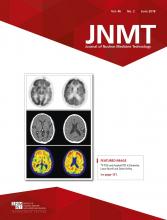Article Figures & Data
Tables
Instrumentation Imaging Parameters Camera type Large field of view (single or multidetector) Energy peaks 140 keV (99mTc)
81 keV (133Xe)
190 keV (81mKrypton)Energy window 20% Collimator Low-energy all-purpose or high-resolution Matrix 128 × 128 (ventilation/SPECT)
256 × 256 (planar)SPECT Orbit 360° (non-circular preferred) Number of projections 60—single head (6°)
120—dual head (3°)Time/projection 10 seconds/projection (aerosol)
20–30 seconds/projection (perfusion)Acquisition type Step-and-shoot or continuous Radiopharmaceuticals—Gas Identity Dose Route of administration 133Xe gas 100 MBq (5 mCi)
Range: 200–750 MBq (5–20 mCi)
Pediatric dose: 10–12 MBq/kg (0.3 mCi/Kg)—minimum dose, 100–120 MBq (3 mCi)Continuous inhalation 81mKrypton (not available in the United States) 40–400 MBq (1–10 mCi) Continuous inhalation Radiopharmaceutical—Aerosol Identity Dose Route of administration 99mTc-diethylenetriamine pentaacetic acid (DTPA) aerosol 900 MBq (25 mCi)
Range: 900–1,300 MBq (25–35 mCi)Continuous inhalation 99mTc-sulfur colloid aerosol 900 MBq (25 mCi)
Range: 900–1,300 MBq (25–35 mCi)Continuous inhalation Radiopharmaceutical—Perfusion Identity Dose Route of administration 99mTc-macroaggregated albumin (MAA) 40 mBq (1 mCi)
Range: 40–150 MBq (1–4 mCi)
200,000–700,000 particles
Pediatric dose: 1.11 MBq/kg (0.03 mCi/kg)
2.59 MBq/kg (0.07 mCi/kg) if 99mTc aerosol study performed
Minimum activity: 14.8 MBq (0.4 mCi)Intravenous







